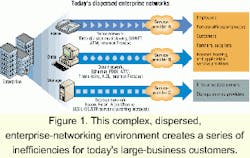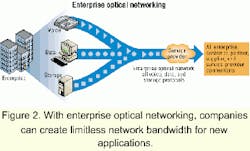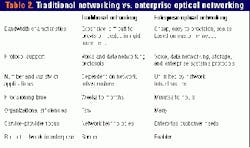Enterprise optical networking: the next generation
A new, holistic approach to corporate networking requires taking the benefits of fiber-optic technology into uncharted territory.
Jon Oltsik, GiantLoop Network Inc.
Today's business initiatives are inexorably linked to network bandwidth. After all, your business can grow only as fast as information can be exchanged and acted upon. This reality is reflected in companies' growing bandwidth demands: 50% of the large corporations surveyed by Forrester Research expect their bandwidth needs to more than double by 2001. Likewise, market analyst RHK Inc. (San Francisco) estimates that many Fortune 1000 companies double their bandwidth requirements every three to six months. RHK states that worldwide bandwidth demand grew roughly 200% from 1998 to 2000 and will increase more than 400% between 2000 and 2002.
Rising bandwidth requirements are primarily due to staggering growth in the levels of data traffic flowing across corporate and public networks. For example, British Telecom expects that data will account for 90% of all network traffic in the U.K. by 2003, according to analyst firm Ovum. Similarly, RHK says AT&T's data traffic is expected to grow nearly 300% from first quarter 1999 through fourth quarter 2000, accounting for close to 76% of total network traffic by the end of this year.
This increasing level of data traffic is a direct result of business initiatives over the past five to 10 years. These business initiatives are built on the back of the following applications:
- Internet and e-business applications. From universal employee e-mail to online exchanges for trading with suppliers and customers, large firms have deployed many new Internet applications in re cent years. For most organizations committed to enterprise information technology (IT), this rapid expansion of the Internet has, in turn, led to unprecedented growth in data traffic. In fact, 24% of the companies interviewed by Forrester Research cite increasing Internet use as a prime cause of escalating bandwidth needs.
- New front-office applications. Along with office suites and other productivity tools, groupware applications like e-mail and calendars have become standard in large enterprise settings. Companies are also deploying new front-office applications-for customer-relationship management, sales force automation, and procurement-that replace paper-based processes and add to the network load.
- Data-intensive back-office applications. e-business is more than just taking orders on a Website. Powerful UNIX servers and IBM mainframes handle the massive amounts of transaction processing needed to support Internet commerce. These systems also run the enterprise resource planning and supply-chain management applications that control companies' procurement, manufacturing, and financial processes. To organize and analyze the wealth of data generated by these applications, large businesses have invested in advanced database and decision-support software that allows them to build and "mine" huge data warehouses for information and insight.
In addition to the infrastructure supporting traditional LAN and wide-area-network (WAN) services, large enterprise companies have deployed a separate backend network infrastructure to handle mission-critical enterprise computing services, including:
- Storage networking. Many large companies have deployed online storage configurations such as Escon, Ficon, or Fibre Channel-based storage area networks and LAN-based network-attached storage to cope with the explosion of corporate data. Although storage networks help utilize storage resources more effectively, data-intensive storage applications running on those networks-such as remote mirroring and backup-have created a challenging new enterprise bandwidth bottleneck for which, until recently, no solution existed.
- Geographically dispersed server clustering. For mission-critical applications such as securities-order processing and clearing, large companies deploy clusters of host computers to ensure data availability and maximize computing cycles by load balancing between computers. To strengthen disaster recovery capabilities, information system staffers often place discrete hosts in different locations with all critical data mirrored between the sites. Companies must implement high-speed fiber-optic links to provide the fast, reliable connectivity needed to keep server clusters synchronized and ensure effective data mirroring, backup, and load balancing.
In the information economy, companies of all sizes will face escalating data growth and incessant demands for more network bandwidth. However, the sheer volumes of data generated by Global 250 organizations will lead to especially complex problems in large firms. Before large firms can solve these problems, however, their chief information officers and IT professionals will need to rethink their traditional concepts of networking technologies, organizations, and service providers.
Historically, enterprise systems and storage networking have been divorced from voice and data networking services. These various networking functions are characterized by:
- Separate protocols. Voice networks employ SONET, time-division multiplexing, ATM, and Internet Protocol (IP) technologies. LAN and WAN data networking, on the other hand, is the domain of Fast Ethernet, FDDI, ATM, frame relay, X.25, virtual private networks, IP, and private line. Enterprise systems and storage networking rely on technologies like Escon, Ficon, Fibre Channel, Fibre Channel arbitrated loop, SCSI, and serial storage architecture (see Table 1).
- Separate organizations. In most Global 250 organizations, voice, LAN, and WAN responsibilities fall under a corporate telecommunications or networking group. Storage and server clustering, however, is the domain of either the corporate data center or enterprise systems group.
- Separate service providers. Voice, data, and enterprise systems groups often choose different service providers for public network connectivity: a long-distance carrier for voice, a separate carrier for data, and a third provider for storage.
Multiple networking technologies require huge investments in equipment and staff. Firms must evaluate, purchase, and maintain a dizzying array of hardware and software to meet current networking needs. They must also find, hire, and constantly train the staff necessary to manage this broad range of complex, rapidly changing technologies. From a financial perspective, large companies looking to deploy and maintain a state-of-the-art network infrastructure face huge, unpredictable capital expenditures for equipment that is often obsolete before it fully depreciates.
Supplier management is a full-time job. With dozens of hardware, software, and service vendors entrenched in the various corporate-networking functions, IT staffs spend inordinate amounts of time and money creating requests-for-proposal, negotiating contracts, testing equipment for vendor interoperability, monitoring service-level agreements, and dealing with vendor finger-pointing when problems arise.
Organizational divisions magnify inefficiencies. With separate organizations for voice, data, and enterprise systems networking, firms create islands of knowledge and resources often unaware of, or indifferent to, the demands of other groups. As a result, the potential for shared equipment, staff, or financial resources is rarely realized.
Other problems include separate organizations, multiple equipment vendors and service providers, different skill levels, and a lack of organizational efficiencies resulting from underused staff and equipment.
Today's fragmented enterprise-networking environment is ill-suited for the rigors of the information economy. New business initiatives and skyrocketing bandwidth demands threaten to bury even the most adept, well-funded IT groups under an avalanche of data traffic. The result? Organizations will struggle with the increasing cost, complexity, and staff requirements associated with building and maintaining an adequate enterprise-networking infrastructure.
Moreover, customers looking to service providers for help with the full spectrum of their networking needs find little relief in current offerings. Incumbent regional and long-distance carriers are hampered by legacy networks that simply were not designed to handle massive volumes of mission-critical corporate data. Existing fiber-optic solutions-such as those that focus on single-protocol (often IP) services, small and medium-sized customers, and wholesale fiber access-lack clear standards and are insufficient for complex enterprise-networking needs.Faced with exploding bandwidth demands, disparate organizations, and limited service-provider offerings, Global 250 companies need a new solution that satisfies growing enterprise bandwidth needs while simultaneously providing the benefits of a unified, optical-network infrastructure. A new approach-enterprise optical networking-solves all of the problems described above.
Enterprise optical networking, a new, holistic approach to corporate networking, is defined as the aggregation of all voice, data and storage-networking traffic on a single, high-bandwidth, fiber-optic infrastructure that spans campus, metropolitan, and intercity networks. Enterprise optical networking is:
- Multiprotocol. Corporate networking encompasses voice, data, storage, and enterprise systems network services, and enterprise optical networking supports all protocols and transports needed to deliver those services: SONET, ATM, IP, Gigabit Ethernet, Escon, Ficon, and Fibre Channel. Aggregating these diverse technologies on a single optical network reduces network complexity, simplifies network management, reduces equipment and connectivity expenses, and creates staffing efficiencies.
- Application-neutral. Simple personal productivity applications like e-mail, complex applications like manufacturing and logistics, and mission-critical storage applications like remote mirroring, all share the same network infrastructure. Since companies no longer have to match applications with the networks that transport them, application deployment times and complexities are greatly reduced.
- Distance-independent. Signal regeneration technology is built into enterprise optical networks. The result? Optical networks can transmit data at the speed of light over virtually unlimited distances. As firms realize the power of an enterprise optical-networking infrastructure, distinctions between LANs, metropolitan area networks (MANs), and WANs virtually disappear, allowing enterprise customers to rationalize redundant service providers, equipment vendors, and internal organizations.
- Infinitely scalable. Thanks to new DWDM technology that increases the number of wavelengths available on a given fiber strand, companies with an enterprise optical-networking infrastructure can simply light more wavelengths as bandwidth demands increase. This makes enterprise optical networking the only choice for the information economy in which network bandwidth requirements are increasingly unpredictable. With rapid, software-based provisioning, companies can deploy new bandwidth-hungry applications without long planning cycles and costly network upgrades, saving enterprise customers time and money.
- Customer-centric. Since enterprise optical networking offers virtually limitless scalability, it allows large companies or their outsourcers to design a custom network infrastructure from the customer premise out to the network core, rather than the traditional carrier approach of building from the network core in to the enterprise. Companies can forever create limitless network bandwidth for new applications, connections to business partners, and the growing array of network-based services such as application hosting and storage services (see Figure 2).
There are numerous attributes and benefits of enterprise optical networking, including the ability to transport and transmit multiple protocols, the reduction of network complexity, and the creation of equipment and staffing efficiencies. It is application neutral, enabling a variety of speeds and simplifying application deployment. Enterprise optical networking is also distance independent, eliminating redundant equipment, service providers, and organizations for LAN, MAN, and WAN services. Infinite scalability can be achieved, saving users time and money by permitting rapid, software-based bandwidth provisioning and "pay-as-you-go" upgrades. Finally, DWDM allows the design of customer-centric network solutions with flexible, scalable bandwith and protocol support.
Industry pundits have touted the potential of optical networks for years. But it is only now that key developments in the fiber-optic industry-such as the emergence of new DWDM equipment and growing fiber-optic cable deployments-have come together to lay the foundation for a revolutionary network infrastructure (see Table 2).However, these developments alone are not a panacea for current enterprise-networking challenges. The technical, financial and labor resources needed to transform new optical technologies into true enterprise optical-networking services make building an internal optical enterprise infrastructure prohibitively expensive and time-consuming for most companies. Instead, next-generation service providers will deliver cost-effective solutions to enterprise customers by creating economies of scale in the following areas:
- Skills. To aggregate myriad corporate data formats on a single network, enterprise optical-networking service providers hire, train, and retain in a full range of networking and enterprise systems equipment, protocols, and applications.
- Staff. The IT industry faces a critical labor shortage. According to META Group, some 850,000 U.S. IT positions will go unfilled in 2000. This shortage is particularly acute in emerging fields such as optical networking. By offering the opportunity to work with the most advanced optical-networking technologies, enterprise optical-networking service providers present strong professional employment incentives to attract talented engineering staffs.
- Service. Enterprise optical networking relies on the continuous monitoring of network resources for optimal performance. To hew to this standard, service providers are making significant investments in advanced-network control centers that monitor network status, distributed applications, and e-business processes.
- Software. To take full advantage of the flexibility and management functionality built into the latest optical-networking equipment, enterprise optical-networking service providers are devoting substantial software-development resources to building Internet-based provisioning and reporting tools that offer true self-service capabilities.
- Standards. Enterprise-network IT staffs expend a lot of time, energy, and money keeping up with a slew of new technologies and evolving often-incompatible standards. By committing to best-of-breed equipment and conducting "pre-production" vendor interoperability testing, enterprise optical-networking service providers are insulating customers from technology integration and obsolescence headaches and keeping underlying network technology truly invisible to the enterprise customer.
- Sourcing. Today, "enterprise company" is synonymous with "global company," and global companies need global solutions. Enterprise optical-networking service providers deploy and/or lease fiber around the globe, ensuring an end-to-end solution and assuming responsibility for costly, time-consuming contract negotiations and network integration efforts.
- Speed. With the rapid pace of technology change, even the most innovative firms gain just a few months of competitive advantage from new, technology-based initiatives. In this fast-paced business environment, companies cannot afford to wait months for enterprise IT groups to deploy the network infrastructure required by new applications. However, firms also can't afford the business impact of a quickly deployed, but poorly planned, solution that may not scale to meet business needs. By combining networking and applications expertise with the rapid service delivery made possible by fiber-optic technology, enterprise optical-networking service providers deliver reliable optical-networking solutions at the speed necessary in today's business climate.
Enterprise optical networking will become the archetype for corporate networking for the simple reason that no other communications infrastructure can support the requirements of business in the information economy. Only optical technologies have the speed, scale, and flexibility needed to satisfy Global 250 companies' evolving networking needs.
The ultimate effects of enterprise optical networking, however, will be felt well beyond the four walls of the network control center. It represents the beginnings of a massive change in the way large companies will view communications and computing technologies and the very way in which businesses interact. As new optical technologies effectively eliminate bandwidth limitations, enterprise optical networking will:
- Fundamentally change enterprise firms' IT architecture. The power of enterprise optical networking will spur a move to a distributed computing architecture characterized by specialized information appliances, built-in redundancy, and fault tolerance throughout the network. This transformation will, in turn, affect enterprise software development efforts, further accelerating object-based Java/Jini-type programming.
- Enable real-time global computing. The shift to an advanced optical-networking infrastructure will help firms synchronize transaction systems and other enterprise-computing resources around the globe, allowing companies to increase technology efficiencies, manage information assets more effectively, improve forecasting, and better serve customers.
- Fulfill the promise of advanced multimedia applications. Firms will finally be able to deploy bandwidth-intensive technologies, such as 3-D modeling and streaming media, facilitating adoption of applications like video-on-demand, distance learning, and telemedicine.
- Catalyze amazing new business connections. The adoption of enterprise optical networking will engender an interactive community of companies, customers, suppliers, partners, and service providers. On this all-optical network, custom-designed and built for enterprise customers, partners will collaborate, share information, and conduct commerce faster, cheaper, and on a greater scale than ever before.
Simply put, bandwidth demand exceeds bandwidth supply. Global 250 and other large enterprises should investigate the virtually limitless bandwidth for both data and storage that is offered by the enterprise optical network. While some of these companies are trying to develop their own fiber-optic networks with varying degrees of success, a new category, optical service providers, are now able to deliver proven turnkey enterprise optical-network solutions.
These solutions, built out from the customer premise to the network edge, will comprise professional services, connection/implementation programs, and managed network services. Once this "bandwidth maximization engine" has been put into place and the incredible advantages of optical networking are realized, every facet of the way business is currently conducted around the world will change.
Jon Oltsik is vice president of corporate marketing for GiantLoop Network Inc. (Waltham, MA). The company's Website is www.giantloop.com.




